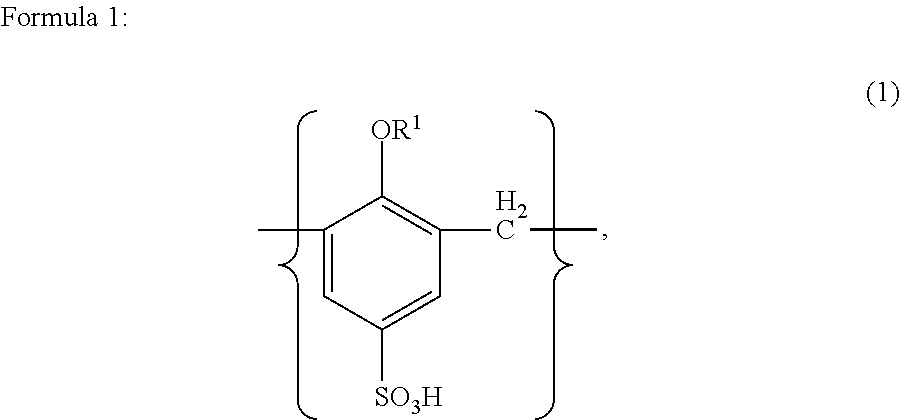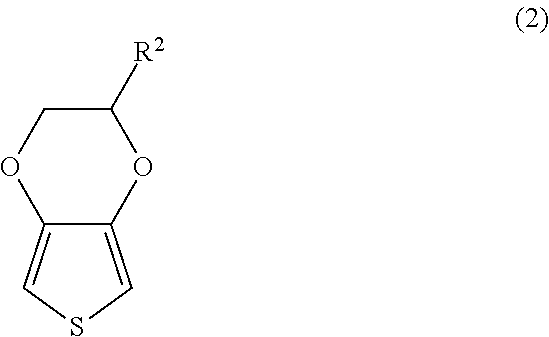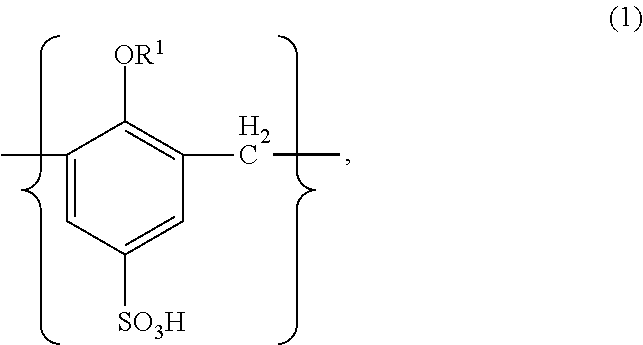Method for manufacturing solid electrolytic capacitor
a manufacturing method and electrolytic capacitor technology, applied in the manufacture of electrolytic capacitors, capacitor details, electrolytic capacitors, etc., can solve the problems of not fully satisfying the initial resistance value and heat resistance value, still not reaching the characteristics that could be fully satisfied, and producing precipitation. , to achieve the effect of excellent charge discharge characteristic and high voltage resistan
- Summary
- Abstract
- Description
- Claims
- Application Information
AI Technical Summary
Benefits of technology
Problems solved by technology
Method used
Image
Examples
examples
[0083]Next, the present invention is explained more in detail with reference to the examples. It is noted that the present invention is not narrowly construed to the examples. In addition, the percentages (%) for the concentration and the purity regarding the solution and the dispersion liquid are based on the mass standard unless otherwise noted. Prior to the explanation of the Examples, the Preparation Examples for the dispersion liquids of the conductive polymer are explained in Preparation Examples A to C. The Preparation Examples for the solution where a cyclic organic compound having at least one hydroxyl group is dissolved are explained in Preparation Example 1 to 28. The Preparation Examples of the solution where an organic compound other than the cyclic organic compound (i.e., cyclic organic compound having at least one hydroxyl group) are explained in Preparation Examples 29 to 32, which are used in Comparative Examples for the comparison with the cyclic organic compound h...
preparation example a
The Dispersion Liquid of the Conductive Polymer
[0084]600 g of 4% aqueous solution of polystyrene sulfonic acid (manufactured by Tayca Corporation; the weight average molecular weight of 100,000) were put into a stainless steel vessel with a volume of 1 L, into which 0.3 g of ferrous sulfate with 7 hydrates were added. Then, 4 mL of ethylenedioxy thiophene (i.e., 3,4-ethylenedioxy thiophene;) was dropped slowly. Then, stirring was continued with a stirrer made of stainless steel. Electrolytic oxidation polymerization was performed in a constant current value of 1 mA / cm2 for 18 hours at room temperature.
[0085]After the electrolytic oxidation polymerization as explained above, dilution was made with 6 times of water. Then, dispersion process was performed by using a ultrasonic wave homogenizer (US-T300 manufactured by Nippon Seiki Co., Ltd.) for 30 minutes. Then, 100 g of a cation-exchange resin AMBERLITE 120B (manufactured by Organo Corporation) was added, and stirring was continued f...
preparation example b
Dispersion Liquid of the Conductive Polymer
[0088]Instead of ethylenedioxy thiophene, methylated ethylenedioxy thiophene was used. Except for the above, the same procedures as Preparation Example A to prepare the dispersion liquid of the conductive polymer were performed to prepare Dispersion Liquid B of the conductive polymer.
[0089]It is noted that the methylated ethylenedioxy thiophene as used above was synthesized as shown in the following Synthetic Example 1.
PUM
| Property | Measurement | Unit |
|---|---|---|
| boiling point | aaaaa | aaaaa |
| temperature | aaaaa | aaaaa |
| mass % | aaaaa | aaaaa |
Abstract
Description
Claims
Application Information
 Login to View More
Login to View More - R&D
- Intellectual Property
- Life Sciences
- Materials
- Tech Scout
- Unparalleled Data Quality
- Higher Quality Content
- 60% Fewer Hallucinations
Browse by: Latest US Patents, China's latest patents, Technical Efficacy Thesaurus, Application Domain, Technology Topic, Popular Technical Reports.
© 2025 PatSnap. All rights reserved.Legal|Privacy policy|Modern Slavery Act Transparency Statement|Sitemap|About US| Contact US: help@patsnap.com



